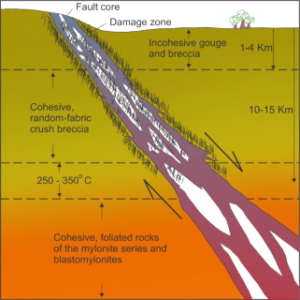2.1 Crustal Level: Brittle versus Ductile Deformation
Metamorphic and intrusive igneous rocks, which make up most typical crystalline aquifers, are generated at depth under high temperature and pressure. Under such conditions, rocks are deformed in a ductile manner by flowing (rather than breaking) when in a solid state (Davis et al., 2011); this is called ductile deformation. In addition, pervasive structures, such as foliation (planar structure formed by mineral orientation), are developed. Some of these crystalline rocks are eventually uplifted to the earth surface, which is why these rocks crop out at the surface throughout vast areas.
During uplift, rocks move to shallower levels in the crust where temperature and confining pressures are gradually lower. Under these conditions the deformation becomes brittle and under certain stress magnitudes the rock breaks. The uplift process, from depths of tens of kilometers to the surface, takes place over geologic time. The rocks may undergo a succession of deformation phases associated with different tectonic events that generate structures compatible with the temperature and pressure conditions existing at each depth.
-
Metamorphic foliations and tight folds are ductile structures generated at great depths; they are the oldest in the deformational history of the rocks. They are not by themselves relevant to groundwater circulation because there are no pores associated with them. However, these structures create mechanical anisotropy—anisotropy means different properties in different directions—in rock units. This may influence the geometry of the fracture system that will be generated later, as described in Section 3.4.
-
Shear zones, formed at depths greater than 10 to 15 km under ductile deformation, are composed of a series of strongly foliated rocks called mylonites (Figure 9). Their development process does not, by itself, generate porosity.
-
Faults, along with minor faults and joints, are generated under brittle deformation and are formed at crustal levels shallower than 10 to 15 km (Davis et al., 2011). It is the latest deformation that takes place during uplift. Generally, faults create secondary porosity and permeability within the rocks (Figure 9). This is discussed in detail in section 4.1.4.

Figure 9 – Crustal levels and the materials formed at fault zones from shallower to deeper depths: incohesive breccia, cohesive random-fabric breccia, and foliated mylonitic rock. Fractures are formed by brittle deformation at shallow depths of less than 10–15 km (modified from Sibson, 1977).
Although ductile structures (such as foliation) do not produce porosity, they usually influence the fracture network configuration because they are commonly reactivated during brittle deformation (section 3.4). An important implication is that rocks with foliation, veins, and other previous anisotropies, will tend to have a denser fracture network and a higher transmissivity, as detailed in Section 3.5.
